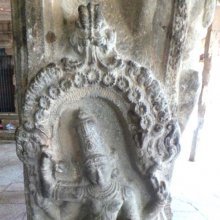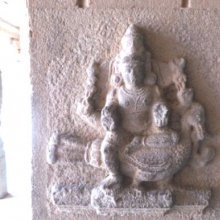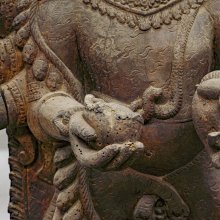Trishula, Triśūla, Tri-shula: 32 definitions
Introduction:
Trishula means something in Buddhism, Pali, Hinduism, Sanskrit, the history of ancient India, Marathi. If you want to know the exact meaning, history, etymology or English translation of this term then check out the descriptions on this page. Add your comment or reference to a book if you want to contribute to this summary article.
Trishula has 30 English definitions available.
The Sanskrit term Triśūla can be transliterated into English as Trisula or Trishula, using the IAST transliteration scheme (?).
Images (photo gallery)
(+47 more images available)
Languages of India and abroad
Sanskrit dictionary
[Deutsch Wörterbuch]
Source: Cologne Digital Sanskrit Dictionaries: Böhtlingk and Roth Grosses Petersburger WörterbuchTriśūla (त्रिशूल):—1. (tri + śūla) n. Dreizack [Trikāṇḍaśeṣa 3, 3, 50.] [Hemacandra’s Anekārthasaṃgraha 3, 112.] [Medinīkoṣa kh. 9.] [Mahābhārata 1, 1432.] [Harivaṃśa 10472. fg.] [Rāmāyaṇa 1, 56, 12. 5, 37, 38. 6, 28, 5.] [Vetālapañcaviṃśati 13, 2.] [Bhāgavatapurāṇa 6, 11, 17.] [Rājataraṅgiṇī 2, 133.] m. [Arjunasamāgama 7, 21.] die Waffe Śiva’s [Mahābhārata.3,5009.] [Harivaṃśa 10658.] [Matsyapurāṇa] in [Oxforder Handschriften 39,a, Nalopākhyāna 3.] hasta von Śiva [Mahābhārata 14, 207.] varapāṇin desgl. [12, 10357.] triśūlāṅka [Śivanāmasahasra]
--- OR ---
Triśūla (त्रिशूल):—2. (wie eben)
1) adj. mit dem Dreizack versehen, Beiname Śiva’s: purīmāhātmya aus dem [SKANDA-Pāṇini’s acht Bücher] [MACK. Coll. 1, 73.] —
2) Nomen proprium eines Gebirges [Lassen’s Indische Alterthumskunde I, 48.]
Source: Cologne Digital Sanskrit Dictionaries: Sanskrit-Wörterbuch in kürzerer FassungTriśūla (त्रिशूल):—1. n. Dreizack , insbes. als Waffe Śiva's m. fehlerhaft.
--- OR ---
Triśūla (त्रिशूल):—2. —
1) Adj. mit dem Dreizack versehen ( Śiva). —
2) m. Nomen proprium eines Gebirges.
Sanskrit, also spelled संस्कृतम् (saṃskṛtam), is an ancient language of India commonly seen as the grandmother of the Indo-European language family (even English!). Closely allied with Prakrit and Pali, Sanskrit is more exhaustive in both grammar and terms and has the most extensive collection of literature in the world, greatly surpassing its sister-languages Greek and Latin.
See also (Relevant definitions)
Starts with (+5): Trishula-kashu, Trishuladanda, Trishuladhara, Trishuladharin, Trishuladharini, Trishulaganga, Trishulahasta, Trishulahata, Trishulaka, Trishulakara, Trishulakhata, Trishulanka, Trishulapani, Trishulapattitadhara, Trishulaprahara, Trishulapuri, Trishulapurimahatmya, Trishulasthapana, Trishulastra, Trishulaubinahullu.
Ends with: Jvalitatrishula, Mahatrishula, Svatrishula.
Full-text (+86): Trishulahasta, Trishulanka, Trishulapattitadhara, Trishulapuri, Trishulaganga, Trishulakhata, Trishulavarapanin, Shula, Shanaishcara, Tiriculam, Pinaka, Trishulaya, Tiri-culamuttirai, Shul, Mahatrishula, Trishulay, Trishulin, Trishula-kashu, Trishul, Sayudha.
Relevant text
Search found 40 books and stories containing Trishula, Tri-shula, Tri-śūla, Tri-sula, Tri-śula, Triśūla, Trisula, Triśula; (plurals include: Trishulas, shulas, śūlas, sulas, śulas, Triśūlas, Trisulas, Triśulas). You can also click to the full overview containing English textual excerpts. Below are direct links for the most relevant articles:
The Religion and Philosophy of Tevaram (Thevaram) (by M. A. Dorai Rangaswamy)
Chapter 4.6 - (f) Symbology of Trisula (the trident) < [Volume 2 - Nampi Arurar and Mythology]
Chapter 3.7 - Andhakasura-murti (conquest of Andhaka Asura) < [Volume 2 - Nampi Arurar and Mythology]
Chapter 4.3 - (b) The seven Tandava Dances of Shiva < [Volume 2 - Nampi Arurar and Mythology]
Amaravati Art in the Context of Andhra Archaeology (by Sreyashi Ray chowdhuri)
Lower Kṛṣṇā Valley (27): Chinna Ganjam < [Chapter 2 - Amarāvatī and other Archaeological Sites of Ancient Andhra Pradesh]
Triratna (triple refuge) < [Chapter 3 - Amarāvatī and the Formative Stage of the Buddhist Art]
Bodhisattva’s Enlightenment < [Chapter 3 - Amarāvatī and the Formative Stage of the Buddhist Art]
The Indian Buddhist Iconography (by Benoytosh Bhattachacharyya)
108 forms of Avalokiteśvara (76): Viṣṇupāṇi Lokeśvara
108 forms of Avalokiteśvara (83): Sarasiri Lokeśvara
Rudra-Shiva concept (Study) (by Maumita Bhattacharjee)
2. Vājasaneyi-saṃhitā (b): Rudra’s weapons < [Chapter 2 - Rudra-Śiva in the Saṃhitā Literature]
2.17. Rudra as Śitikaṇṭha < [Chapter 6a - The Epithets of Rudra-Śiva]
44. Identity between Śiva and Nārāyaṇa < [Chapter 5 - Rudra-Śiva in the Purāṇic Literature]
Sripura (Archaeological Survey) (by Bikash Chandra Pradhan)
Pictographs on the Metal Seals < [Chapter 3 - Sculptural Programme]
Scultures of Sadaksari-Lokesvara < [Chapter 3 - Sculptural Programme]
Copper Plate Inscriptions: Salient Features < [Chapter 4 - The Corpus of Inscriptions]
Related products






